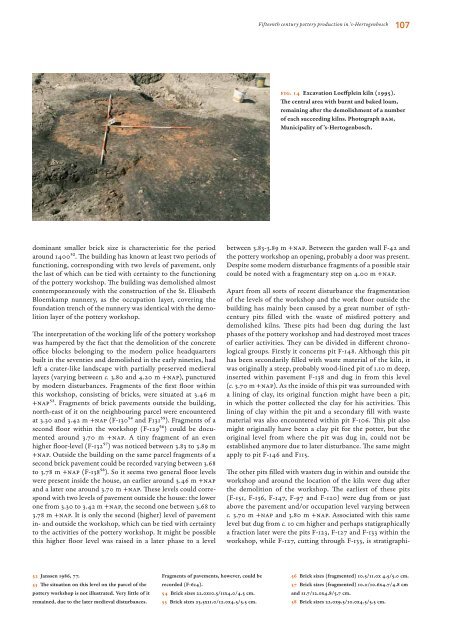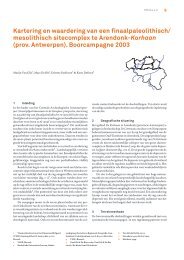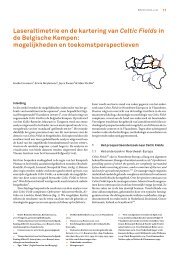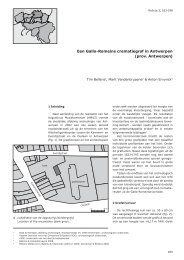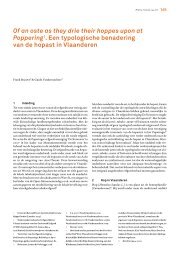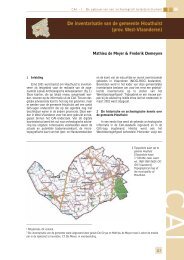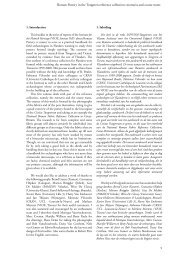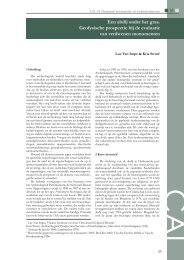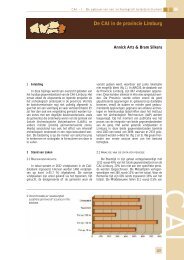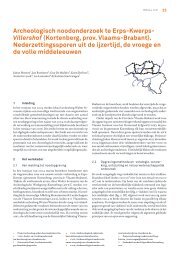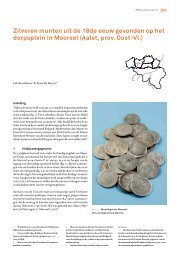Exchanging Medieval Material Culture Studies on archaeology and ...
Exchanging Medieval Material Culture Studies on archaeology and ...
Exchanging Medieval Material Culture Studies on archaeology and ...
You also want an ePaper? Increase the reach of your titles
YUMPU automatically turns print PDFs into web optimized ePapers that Google loves.
dominant smaller brick size is characteristic for the period<br />
around 140052. Th e building has known at least two periods of<br />
functi<strong>on</strong>ing, corresp<strong>on</strong>ding with two levels of pavement, <strong>on</strong>ly<br />
the last of which can be tied with certainty to the functi<strong>on</strong>ing<br />
of the pottery workshop. Th e building was demolished almost<br />
c<strong>on</strong>temporaneously with the c<strong>on</strong>structi<strong>on</strong> of the St. Elisabeth<br />
Bloemkamp nunnery, as the occupati<strong>on</strong> layer, covering the<br />
foundati<strong>on</strong> trench of the nunnery was identical with the demoliti<strong>on</strong><br />
layer of the pottery workshop.<br />
Th e interpretati<strong>on</strong> of the working life of the pottery workshop<br />
was hampered by the fact that the demoliti<strong>on</strong> of the c<strong>on</strong>crete<br />
offi ce blocks bel<strong>on</strong>ging to the modern police headquarters<br />
built in the seventies <strong>and</strong> demolished in the early nineties, had<br />
left a crater-like l<strong>and</strong>scape with partially preserved medieval<br />
layers (varying between c. 3.80 <strong>and</strong> 4.20 m +nap), punctured<br />
by modern disturbances. Fragments of the fi rst fl oor within<br />
this workshop, c<strong>on</strong>sisting of bricks, were situated at 3.46 m<br />
+nap53. Fragments of brick pavements outside the building,<br />
north-east of it <strong>on</strong> the neighbouring parcel were encountered<br />
at 3.30 <strong>and</strong> 3.42 m +nap (F-13054 <strong>and</strong> F13155). Fragments of a<br />
sec<strong>on</strong>d fl oor within the workshop (F-12956) could be documented<br />
around 3.70 m +nap. A tiny fragment of an even<br />
higher fl oor-level (F-13257) was noticed between 3.83 to 3.89 m<br />
+nap. Outside the building <strong>on</strong> the same parcel fragments of a<br />
sec<strong>on</strong>d brick pavement could be recorded varying between 3.68<br />
to 3.78 m +nap (F-13858). So it seems two general fl oor levels<br />
were present inside the house, an earlier around 3.46 m +nap<br />
<strong>and</strong> a later <strong>on</strong>e around 3.70 m +nap. Th ese levels could corresp<strong>on</strong>d<br />
with two levels of pavement outside the house: the lower<br />
<strong>on</strong>e from 3.30 to 3.42 m +nap, the sec<strong>on</strong>d <strong>on</strong>e between 3.68 to<br />
3.78 m +nap. It is <strong>on</strong>ly the sec<strong>on</strong>d (higher) level of pavement<br />
in- <strong>and</strong> outside the workshop, which can be tied with certainty<br />
to the activities of the pottery workshop. It might be possible<br />
this higher fl oor level was raised in a later phase to a level<br />
52 Janssen 1986, 77.<br />
53 Th e situati<strong>on</strong> <strong>on</strong> this level <strong>on</strong> the parcel of the<br />
pottery workshop is not illustrated. Very little of it<br />
remained, due to the later medieval disturbances.<br />
Fragments of pavements, however, could be<br />
recorded (F-614).<br />
54 Brick sizes 22.0x10.5/11x4.0/4.5 cm.<br />
55 Brick sizes 23.5x11.0/12.0x4.5/5.5 cm.<br />
Fifteenth century pottery producti<strong>on</strong> in ’s-Hertogenbosch 107<br />
Fig. 14 Excavati<strong>on</strong> Loeff plein kiln (1995).<br />
Th e central area with burnt <strong>and</strong> baked loam,<br />
remaining aft er the demolishment of a number<br />
of each succeeding kilns. Photograph bam,<br />
Municipality of ’s-Hertogenbosch.<br />
between 3.83-3.89 m +nap. Between the garden wall F-42 <strong>and</strong><br />
the pottery workshop an opening, probably a door was present.<br />
Despite some modern disturbance fragments of a possible stair<br />
could be noted with a fragmentary step <strong>on</strong> 4.00 m +nap.<br />
Apart from all sorts of recent disturbance the fragmentati<strong>on</strong><br />
of the levels of the workshop <strong>and</strong> the work fl oor outside the<br />
building has mainly been caused by a great number of 15thcentury<br />
pits fi lled with the waste of misfi red pottery <strong>and</strong><br />
demolished kilns. Th ese pits had been dug during the last<br />
phases of the pottery workshop <strong>and</strong> had destroyed most traces<br />
of earlier activities. Th ey can be divided in diff erent chr<strong>on</strong>ological<br />
groups. Firstly it c<strong>on</strong>cerns pit F-148. Although this pit<br />
has been sec<strong>on</strong>darily fi lled with waste material of the kiln, it<br />
was originally a steep, probably wood-lined pit of 1.10 m deep,<br />
inserted within pavement F-138 <strong>and</strong> dug in from this level<br />
(c. 3.70 m +nap). As the inside of this pit was surrounded with<br />
a lining of clay, its original functi<strong>on</strong> might have been a pit,<br />
in which the potter collected the clay for his activities. Th is<br />
lining of clay within the pit <strong>and</strong> a sec<strong>on</strong>dary fi ll with waste<br />
material was also encountered within pit F-106. Th is pit also<br />
might originally have been a clay pit for the potter, but the<br />
original level from where the pit was dug in, could not be<br />
established anymore due to later disturbance. Th e same might<br />
apply to pit F-146 <strong>and</strong> F115.<br />
Th e other pits fi lled with wasters dug in within <strong>and</strong> outside the<br />
workshop <strong>and</strong> around the locati<strong>on</strong> of the kiln were dug aft er<br />
the demoliti<strong>on</strong> of the workshop. Th e earliest of these pits<br />
(F-151, F-136, F-147, F-97 <strong>and</strong> F-120) were dug from or just<br />
above the pavement <strong>and</strong>/or occupati<strong>on</strong> level varying between<br />
c. 3.70 m +nap <strong>and</strong> 3.80 m +nap. Associated with this same<br />
level but dug from c. 10 cm higher <strong>and</strong> perhaps statigraphically<br />
a fracti<strong>on</strong> later were the pits F-123, F-127 <strong>and</strong> F-133 within the<br />
workshop, while F-127, cutting through F-133, is stratigraphi-<br />
56 Brick sizes (fragmented) 10.5/11.0x 4.5/5.0 cm.<br />
57 Brick sizes (fragmented) 10.0/10.6x4.7/4.8 cm<br />
<strong>and</strong> 11.7/12.0x4.8/5.7 cm.<br />
58 Brick sizes 22.0x9.5/10.0x4.5/5.5 cm.


